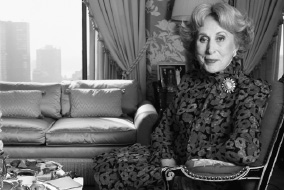Estée Lauder
Estée Lauder, queen of cosmetics, died on April 24th 2004, at a mature age

A NUMBER of newspapers thought Estée Lauder was 97 when she died. Others averred that she was 95. Most agreed that, until a broken hip slowed her down in 1994, she did not look her age, whatever that was. If anything, the hair had grown blonder and the skin tighter. Outrageous purple outfits, topped by natty hats, reproduced something of the glow of youth.
Subservience to hard facts, such as time and decay, seldom held Mrs Lauder back. Her own background was a study in selective self-improvement. By changing her name, acquiring that dainty little lift of an accent aigu, she suggested to customers that her background might be aristocratic and even European. French and Italian blood was hinted at, as well as a convent education. Her father, a monarchist by her telling, felt undressed in the street on Sundays without a cane and gloves.
These details were sprung on the world in 1985, in a book that accompanied the launch of a new perfume, “Beautiful”. For the promotion in Paris, Mrs Lauder had bought up all the pinks in the city to match both the perfume boxes and the book’s cover. This sensory extravaganza was designed to eclipse an unauthorised “inside story” of her life. Under covers of cream and blue (so tastelessly passé!) her rival revealed that Mrs Lauder’s parents, Hungarian Jews, had run a seed and hardware store in Queens, a run-down borough of New York. The young Estée had probably not finished her studies at Newtown High School. Her first jars of face cream had been cooked up not just in a kitchen over a gas stove, but also in a makeshift lab in a stable, and by an uncle whose chemical experiments stretched not only to “Viennese Cream” but to lice-killer and embalming fluid.
These revelations, about a woman who now counted among her friends Princess Diana, Nancy Reagan, the Gorbachevs and the Begum Aga Khan, were somewhat irritating. Yet it was scarcely a tale to be ashamed of. Young Josephine Esther Mentzer, as she began, was convinced from childhood that women should be beautiful. She also hoped to make a fortune by persuading them that, if they bought her creams, their beauty would last for ever. It is a story, after all, that women tend to need to believe.
With tireless energy, she devoted her life to both causes. She began in the 1930s in the beauty salons of Queens, finding an audience held captive under hairdryers and dabbing their hot cheeks with her uncle’s inventions. In 1948, Saks Fifth Avenue took a consignment; it sold out in two days. Steadily, Mrs Lauder acquired shiny counters in more and more department stores. With the help of a friend she branched out in 1953 from creams into Youth-Dew, a bestselling bath oil and perfume combined, and became the doyenne of all beauty.
Tactility was her byword. She loved to plunge her fingers in her own gently simmering creations, palpating and inhaling them. Her creams came in heavy jars, her lipsticks in cool metal sheaths, to advertise their quality. Whenever she could she smoothed them on customers herself, achieving a “gentle glow” that was immediate and miraculous. For a time, Fifth Avenue was not safe from her. Sales staff at Estée Lauder counters were trained by her to get similarly intimate with customers. Free gifts, then an innovation, were handed out with every purchase, and free samples were sent to aristocrats in Europe. The distinctive Estée Lauder blue-green was devised to harmonise with most rich people’s bathrooms. By 2000, more than half of all cosmetics sold in America were hers.
Whether women actually became more beautiful by applying Body PerformanceAnti-Cellulite Visible Contouring Serum, or whether they would have done as well with a quick douse in cold water, is impossible to say. Clearly, many felt better for it. The very names of these products, energetic and pseudo-scientific, implied that the limits of knowledge had been searched. Mrs Lauder could have cut prices, but refused. Her Crème de la Mer, developed by a NASA scientist, cost $110 for an ounce of vitamins pulped with seaweed. But cheapness, she said, would shake her customers’ faith.
Over the decades she became very rich. By this year, her personal fortune stood at $233m and the worth of her company at $5.4 billion, with annual sales of $5 billion in 130 countries. Mrs Lauder was asked to be ambassador to Luxembourg, but declined when her husband said he did not want to carry her bags. Fabulous dinners were arranged, with gifts of Cartier silverware and with the candles set low on the tables to cast a flattering upward light on the assistance. The New York gossip columns trailed her obsessively, and still could not find out how old she was.
Time, however, also trailed her, with his ghastly wrinkled face and his sallow hue that co-ordinated with no bathrooms. In 1988 she asked her elder son Leonard, then CEO of the company, to start dyeing his hair, as he was making her look old. That year the company brought in bleached wood and etched glass for its counters, a new blue for its packaging and more androgynous models who glowed with energy and health. Long before the death of the matriarch, Estée Lauder Companies Inc had been gently, but necessarily, moving out of her ageing shadow.